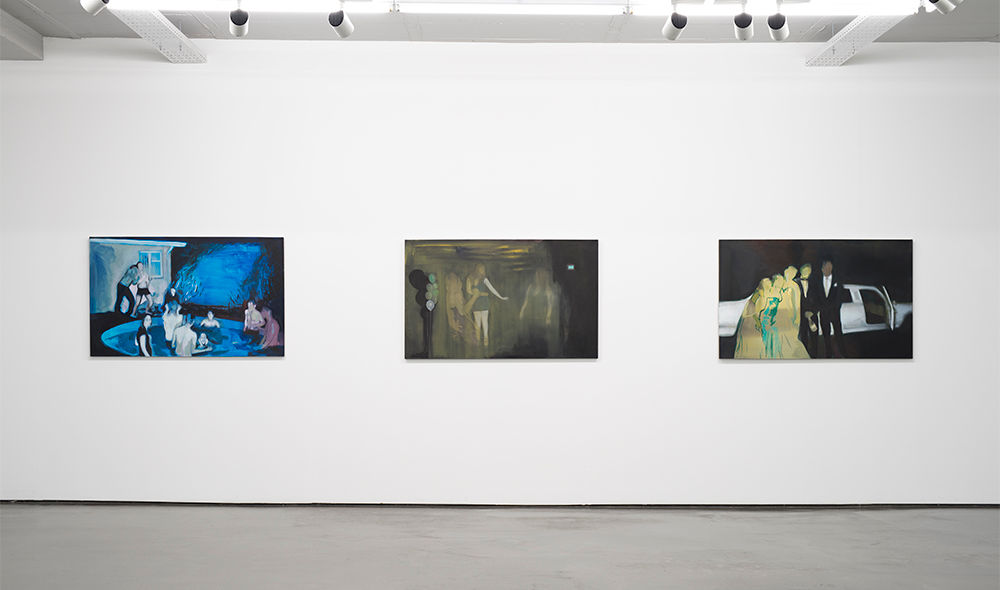KATE GOTTGENS
Famine
EXHIBITION TEXT
Solo Exhibition
10.09.16 – 06.10.16
Johannesburg
SMAC Gallery is proud to present Famine, a solo exhibition by Kate Gottgens.
The neuroscientists pin it all on the first few years. In a period of rapid proliferation, the brain’s architecture is established. Psychologists from Sigmund Freud forward, across the wars and the digital insurgence, have generally agreed. That is when the code is laid down. Does she smother you with love, or does she leave you alone to wail in the darkness until you run dry and come to know your self? This is the making of us. But there is a second imprint. Another peak season when everything is at stake, every choice an irrevocable gamble. This will be the object of her next painterly investigation.
She begins at the onset of winter. The scent of turpentine is sharp on the cool, moist air and fallen leaves gather on the surface of the swimming pool, threatening to clog the filter. It is early June, and in the headlines she reads of the father of a former Stanford University athlete, convicted on multiple charges of sexual assault, stating that his son should not go to prison for “20 minutes of action”. Just two months earlier, in a nearby suburban forest, a teenage girl was found dead – strangled and raped. Her killers had taken her iPhone, watch, headset, and diamond ring.
So much freedom, yet none at all. So many choices, so many precautions, it must feel safer to stay at home and scroll. She is thinking back on what it felt like to be 16, 22, 27 – that migration from the nucleus out into the world. Disco fever, clan outings, fraught debutante antics, the constant rush of desire.
She begins to paint, and the paintings are dark, red, velvety – scenes of random excess unfolding in the breathless precarity of night. Even the luminous pool party is nocturnal. There is something pen-like about the backyard enclosure of the scene. For all the squealing delirium and boisterousness of being suddenly semi-naked in the water together, this pool she has painted becomes quite a scary place to be.
The new Radiohead album is playing in her studio – ‘this is a round up; this is a low-flying panic attack’. She paints two girls who’ve wiped out completely – game over. Rohypnol black out. Helpless paralysis. Moments of bulimic partying gone wrong. She wants certain shapes to be illegible – Rorschach-test like blots that both invite and resist being deciphered. Benign objects – a lone cane chair, a pair of shoes, an etiolated standing lamp, the dimly lit ramparts of a concrete bridge or pier – cast slinky shadows that steal the viewer’s attention, momentarily dominating the field of vision, then slipping off again into visual obscurity.
She stands back to take in the picture sequence that has begun to take shape across the canvases. So here it is – youth in all its anxious disbelief and half navigated freedoms. But what is it that she is doing here? Is it anthropology – a documentary case study of sorts based on a random archive of found photographs? If so, what is she studying so intently? The initiation ceremonies of a dying tribe? The denizens of the next generation working their way through the cultural upheavals of their time? No. This study of hers is strictly interdisciplinary, covertly domestic – voyeurism and autobiography entwined, memories and associations projected into glimmering understandings of her immediate genetic kin; her offspring.
But now she must leave. Her studio ruminations are interrupted by a trip – an actual international vacation. She exits her winter darkness and lands in the dilated throes of an American summer; New York, Los Angeles, and for the first time, the spectacularly flat desert-scape of Sin City – ‘Disneyland for grown ups’.
‘What would Thoreau have made of Las Vegas: its lights and rackets, its trash and daydreams, its projections and hollow façades?’ Donna Tartt’s depiction of the place rings true. Her anxieties about changing contexts in the middle of a series are ameliorated, and her project continues.
From the foyer of a sumptuous hotel, she catches a glimpse of the perfect cinematic poolside scenario and poaches a shot with her iPhone – clichéd palm trees, anaesthetic bathers lolling about in a liquid oasis of immaculately chlorinated water, a billowing cloth and an odalisque figure in the foreground. The mood is one of chemically engineered insouciance. She will paint the scene in psychotropic polychromatics.
Back in her studio, she works into the idea with paint, spooky shadows interfering with the mediated idyll. The hand of a young female bather becomes a dark claw at the edge of her bikini. The rendered atmosphere takes on eerie shapes and forms. Now you see it, now you don’t. Once the gaze is locked into the image plain, a range of alternate possibilities becomes disquietingly apparent within the oozy realm of representation. Figures lose form as the ether of incidental drips and murky swells takes artful precedence.
The series is filling out now, and across the sequence she detects spillage – a deliberate, almost adolescent effort at undermining her own accuracy and concision. She has painted a liquid world of emotive blur, forms and figures leaking beyond their boundaries in a general loosening of pigment, body and psyche. Ha! Could it be possible that she has painted the antonym of a selfie?












































